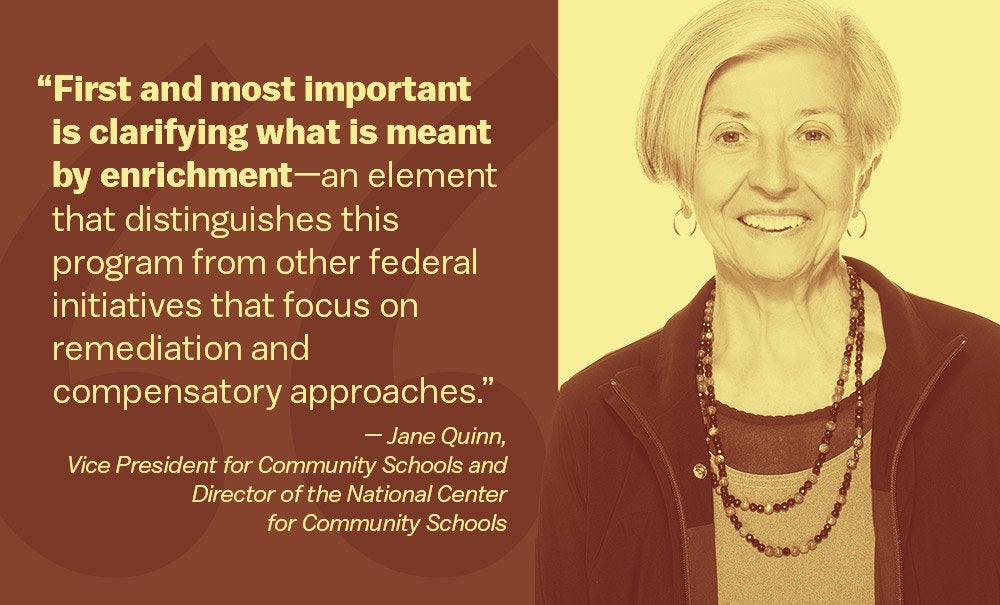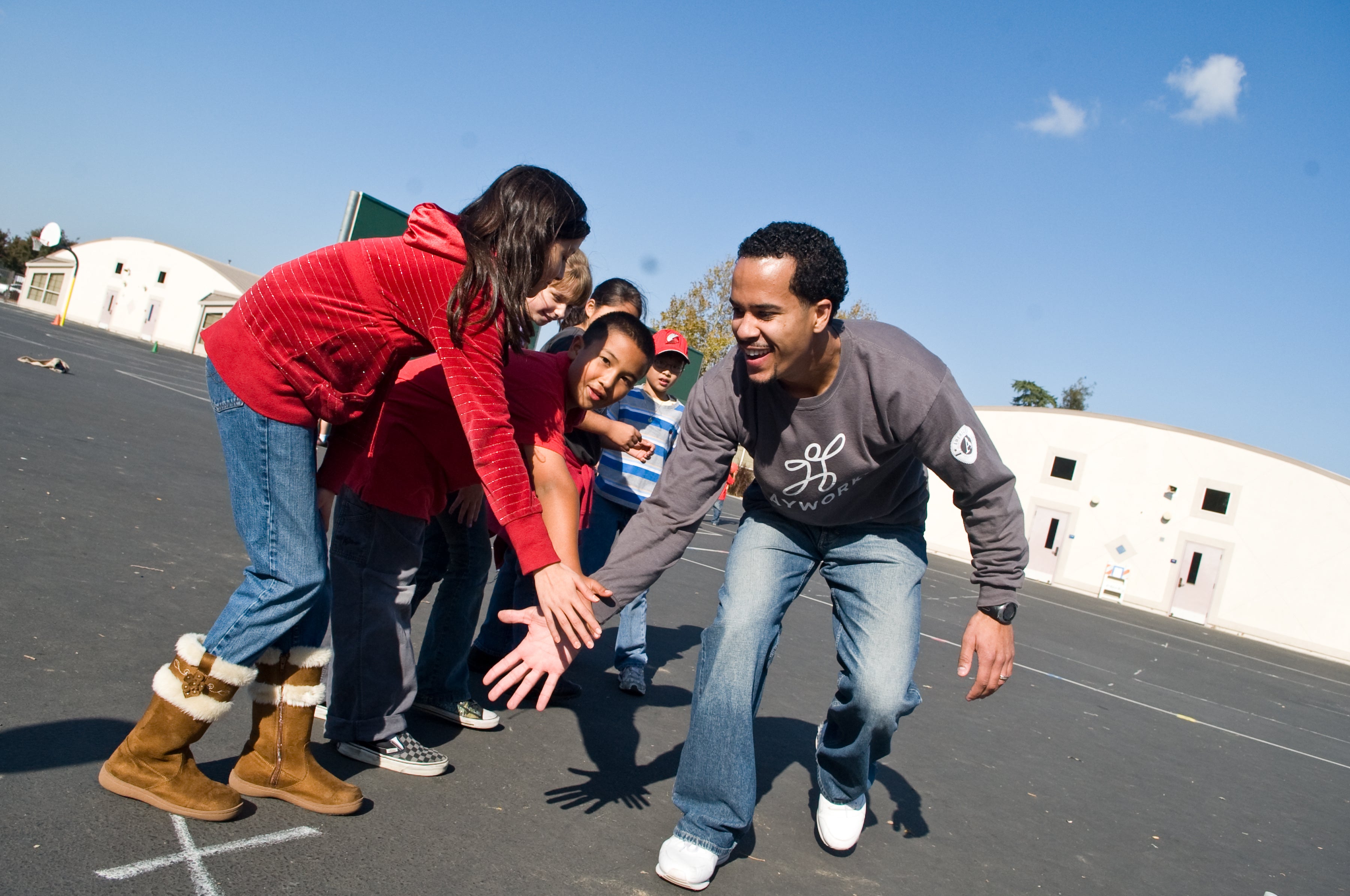Research has shown that out-of-school-time programs are generally effective at producing the benefits for young people that they set out to provide–whether academic gains, enriching experiences, or homework help. But while there are numerous sources of federal and state funds available for afterschool and summer programs, they have seen consistently low rates of student participation.
Take, for instance, the federal 21st Century Community Learning Centers (21st CCLC) program, a part of the Elementary and Secondary Education Act, which provides over $1 billion in funding annually for afterschool and summer programs for children in grades K through 12. Nearly half of the regular participants in the 21st CCLC programs attend fewer than 30 days a year.
We know this because of a recent analysis of the current 21st CCLC policy by Jane Quinn, a venerable figure in the world of out-of-school-time. An expert in afterschool and OST, she has more than five decades of experience in the sector, having working as a social and youth worker for organizations including the Juvenile Protective Association of Chicago, Girls Clubs of America, Children’s Aid—and as program director here at Wallace for seven years in the 1990s.
Quinn is also, at age 78, a newly minted Ph.D. In fact, her findings about the low participation rate in out-of-school-time programs emerged from her dissertation for a doctoral program in urban education at the CUNY Graduate Center. In her thesis, Quinn analyzes the strengths and shortcomings of the current 21st CCLC policy. She argues that the challenge of meager participation can be addressed by “listening to the voices of young people and responding to their desire for engagement and challenge in out-of-school time programs.” We sat down with her to learn more about this and other key findings in the study. Her responses have been edited for length and clarity.

Wallace Foundation: Your study found that nearly half of regular participants in the 21st CCLC programs attend fewer than 30 days a year. Why do you think attendance is so low, and what can be done to improve it?
Jane Quinn: According to the U.S. Department of Education’s data–specifically, their Annual Performance Reports on the 21st Century Community Learning Centers–fully 45 percent of students deemed to be “regular participants” in these programs across the country were reported to attend fewer than 30 days a year. This number is problematic for several reasons, including the fact that we know from prior research that “dosage makes a difference,” meaning that higher program attendance has been shown to produce better outcomes.
When we combine this information about low attendance rates with US DOE [Department of Education] data about the content of 21st CCLC programs, we can begin to surmise why these rates might be so low. The Annual Performance Reports show that two of the three most frequently offered programs in 21st Century Community Learning Centers are homework help and tutoring, suggesting that many of the programs have largely become “more school” and are operating in ways that are not consistent with what young people say they want to do during their non-school hours. Homework help is offered five times more frequently than mentoring–something young people do want–and tutoring is offered four times more frequently than leadership development.
WF: Why is enrichment so important, and why do you think it is so overlooked?
JQ: In the context of the 21st Century Community Learning Centers policy and program, enrichment should be considered important because it is central to the Congressionally mandated purpose of the program. However, the legislation never defines what is meant by enrichment, which has led to multiple interpretations, many of which seem off base to me.
In the context of what we know about young people’s development, enrichment is critical because it starts with student interests and focuses on engaging young people in their own learning. Why is it overlooked in many schools and afterschool programs? Because most people don’t understand what the term means, and some have never seen high-quality enrichment in practice.
Enrichment involves both pedagogy and program content. According to Professor Joseph Renzulli and his University of Connecticut colleagues, enrichment as a pedagogy consists of four elements: it is based on student interest; it uses authentic methodologies, such as project-based learning; it addresses issues that have no existing solution or “right” answer; and it results in culminating activities that allow young people to demonstrate what they have learned. This kind of pedagogy can be applied to a nearly endless array of content. The experts I interviewed had no problem naming the kinds of programming that they viewed as enrichment: book clubs, chess, debate, music, drama, dance, visual arts, robotics, computer programming, community service, sports, mentoring, and leadership development, among others.
I believe that kids shouldn't have to be born rich to have access to enrichment.
WF: Can you describe some characteristics of a good enrichment program?
JQ: Joseph Renzulli says that good enrichment programs are characterized by engagement, enjoyment, and enthusiasm. Many years ago, before I became acquainted with his work, I wrote a column for YouthToday, in which I described a similar set of characteristics. Mine were engagement, exposure, and experience. By exposure, I meant that afterschool and youth development programs can introduce young people to new relationships that build their social capital, to new ideas that enlarge their sense of the world around them, and to new opportunities that feed their aspirations. More affluent children and youth tend to have these kinds of experiences built into their academic and at-home environments. I believe that kids shouldn’t have to be born rich to have access to enrichment.
WF: What are some ways the quality of the programs can be improved, and how should quality be measured?
JQ: When conducting my dissertation research, I was rather astonished to find that the federal 21st Century Community Learning Centers legislation and guidance said almost nothing about program quality, despite the great advancements over the past 25 years in the field’s definition of best practices. The field has produced well-documented guides, rooted in research, about the program factors that are associated with the achievement of positive results.
In addition, we now have several quality assessment tools that program operators can use to examine and strengthen their own practice. One of the best tools, in my view, is the Youth Program Quality Assessment, supported by the Weikart Center. When assessing program quality, we want to look at a range of factors, including program content, health and safety, staff qualifications, youth voice and choice, and interpersonal relationships, including peer-to-peer and adult-youth interactions.
WF: You were involved in the community schools movement from the early days. Can you reflect on where it was back then and how it has evolved?
JQ: Well, I wasn’t there in the really early days—that would have been at the turn of the 20th century when John Dewey, the renowned educational philosopher, wrote a monograph entitled Schools as Social Centers (1902). He had the right idea then, and his work has influenced several generations of community school leaders. In 1998, John Rogers, a UCLA education professor, wrote a seminal paper on the history of community schooling in America, documenting that the current generation of community schools is the fourth such iteration of the work to foster strong relationships between schools and their local communities.
My involvement in this current generation of community schooling includes two phases. First was my work as a program director at Wallace in the mid- to late-1990s, which helped to create the Extended-Service Schools Initiative. And second, was my 18-year tenure as director of the National Center for Community Schools, a program of Children’s Aid.
In my view, all of these early investments contributed substantially to the current community schools movement, which is demonstrating success in informing federal, state, and local education policy and in responding to the documented needs of students and families in what is now being referred to as the post-COVID environment. More than 100 districts nationwide have adopted community schools as a preferred reform strategy, and Congress recently authorized an additional $75 million for the USDOE’s Full-Service Community Schools program, which will provide incentives for additional districts to adopt this strategy.
The first and most important is clarifying what is meant by enrichment
WF: What do you think policymakers should consider if they were to reimagine the 21st Century Community Learning Centers?
JQ: My research offers 10 lessons for strengthening the 21st CCLC policy and program. The first and most important is clarifying what is meant by enrichment —an element that distinguishes this program from other federal initiatives that focus on remediation and compensatory approaches.
A related lesson is finding ways to address the participation rate problem. My sense is that, if programs were required and supported to offer genuine enrichment, rather than a steady diet of homework help and tutoring, young people would make it their businessto participate. And, in turn, outcomes would improve because young people would be engaged in activities of their own choosing.
Another consideration would be how to encourage the creation of authentic partnerships between schools and such community resources as youth development agencies, arts organizations, and science museums. And, since 21st Century funding is one of the few sources of public support for summer programming, the authors of federal guidance could consider placing more emphasis on encouraging and enabling providers to include summer enrichment in their 21st Century-funded programs.
Policymakers should seize the opportunity provided by COVID’s disruptions of the educational landscape by re-envisioning the enrichment role of out-of-school-time programs in the lives of America’s children and youth.



